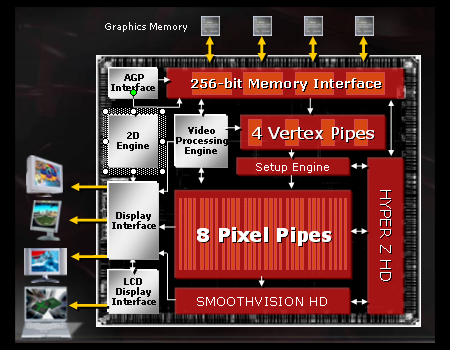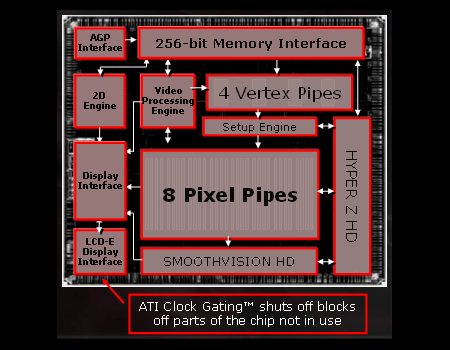ATI Mobility Radeon 9800: Notebooks Get Next Generation Graphics
by Derek Wilson on August 19, 2004 12:05 AM EST- Posted in
- GPUs
Good Things in Small Packages
As indicated earlier, the ATI Mobility Radeon 9800 is based on the R420 core, which powers ATI's latest X800 line of GPUs. In the past, naming may have been a bit of a stretch in terms of comparing mobile graphics solutions with their desktop counterparts, but this time around, the MR9800 bests the desktop 9800 cards in feature set (and doesn't fall that incredibly far behind in performance as we'll soon see).The MR9800 actually supports all the features of the Radeon X800, as it is simply a cut down version of the chip with some enhanced power management features. The real difference between current X800 GPUs on the market and MR9800 is in pixel/vertex pipelines featured. The new mobile chip has 8 pixel pipes and 4 vertex pipes. This also makes the MR9800 look more like a desktop 9800 in fillrate and processing power per clock cycle (though the R420 core will be more efficient). ATI also points to their new chip as the first mobile part to support 256MB of memory using a 256bit wide memory interface. This feature is also a result of the larger power budget available to ATI when targeting the DTR space.
To get a good idea of what's under the hood of MR9800 (and just how alike the desktop X800 really is), here's a block diagram of the chip from ATI's presentation on the part:

Even though ATI had a larger power budget to work with than usual, they couldn't ignore the fact that people will want to be able to use the battery in their system at some point, and thermal and power management both still play a large role in the DTR space. In order to satisfy these needs, ATI's mobile team worked alongside their desktop team to bring power and thermal management features to MR9800 through the R420 design cycle. This allows the R420 to fully support ATI's Powerplay technology right out of the fab. This is why we're seeing the release of a mobile R420 part so soon after the desktop release.
Powerplay is made up of a couple different features. To highlight, we'll touch on a few here. With Power-on-demand, ATI can dynamically adjust clock speeds and voltages based on the usage of the GPU at any given time. This will help to extend battery life when not pushing the graphics subsystem, as will user controlled GPU power management settings. Another important power/thermal management feature of Powerplay is Clock Gating. This amounts to the ability of the GPU to turn off parts of itself when not in use. The granularity of this capability is illustrated in the following slide from ATI's presentation:

We know that in the past, in order to play video, ATI couldn't completely turn off the 3D pipeline, but we are not sure if they have altered this limitation in the MR9800. We'll look into the matter in the future, but this question should answer itself (in video playback tests) when we start seeing reviews of notebooks featuring this GPU.
That does it for the technical details; it's time for some numbers.










31 Comments
View All Comments
DerekWilson - Thursday, August 19, 2004 - link
Thanks Dave, I've tweaked the conclusion a little to reflect this fact.As for the comparison systems, the only way to have a true and fair comparison would have been to grab an AGP version of the mr9800 and dropped it in our desktop system. Since we couldn't do that (or shove other GPUs in the notebook) we went with our standard graphics testbed.
This isn't a direct comparison, and we mentioned that we only used other ATI cards because of that fact. Numbers other than the MR9800 are just for reference.
DaveBaumann - Thursday, August 19, 2004 - link
Derek,Its up to the notebook vendors to qualify the drivers, not ATI. ATI can supply the drivers to the vendors, but its up to the vendors to qualify and release them.
plewis00 - Thursday, August 19, 2004 - link
If the graphics drivers are lagging behind, can't you use a driver which works with all cards - like the Omega ones? The same driver works with the Mobility series and the desktop ones, would that help out? I don't think it disables Powerplay either.Does anyone know what the power drain of the laptop is during a heavy gaming session? Or how long it lasts on batteries?
devonz - Thursday, August 19, 2004 - link
I have to reiterate what #13 said. Why did you compare a P4 notebook against an Athlon 64 desktop!?!?!? And why the differing memory configurations!?!?!? Since you are comparing the video cards, it would SEEM like a good idea to get the configurations as close as possible. Certainly you could get closer to parity than THIS choice!My $.02
Johnmcl7 - Thursday, August 19, 2004 - link
I agree, I keep my laptop graphics cards at stock, it's not worth overclocking for a small performance increase, especially when it is usually difficult to replace the graphics card.John
nserra - Thursday, August 19, 2004 - link
#14 Maybe Powerstrip will do, but not recommended....Besides overclock just to get from 200 to 220, 100 to 110, 50 to 55, 25 to 27 in some games.....
Just to say that when you already have a lot of fps you will get even more (not needed) and when you have low fps, you will continue to have low fps….
In very resuming words OVERCLOCK does not compensate.
Johnmcl7 - Thursday, August 19, 2004 - link
Usually it's just the same as overclocking a desktop graphics card although obviously you have far less headroom.John
skunkbuster - Thursday, August 19, 2004 - link
just out of curiosity, anyone know if it's possible to overclock a video card in a laptop?reboos - Thursday, August 19, 2004 - link
comparing a Athlon64 3200+ w/ 1 gig of RAM to a Northwood 3.2 with 2gb of RAM. I don't get it. :\Shalmanese - Thursday, August 19, 2004 - link
No Doom 3 benchmarks? :o :(